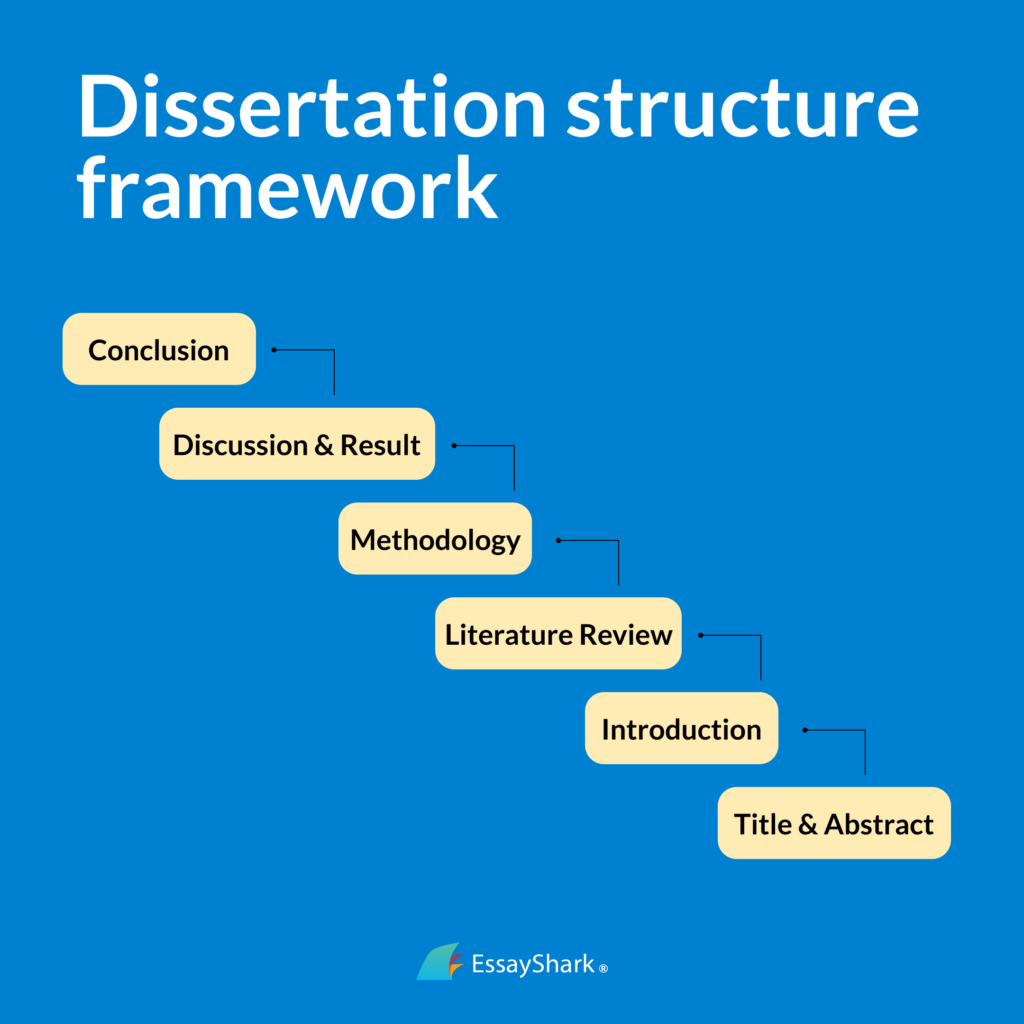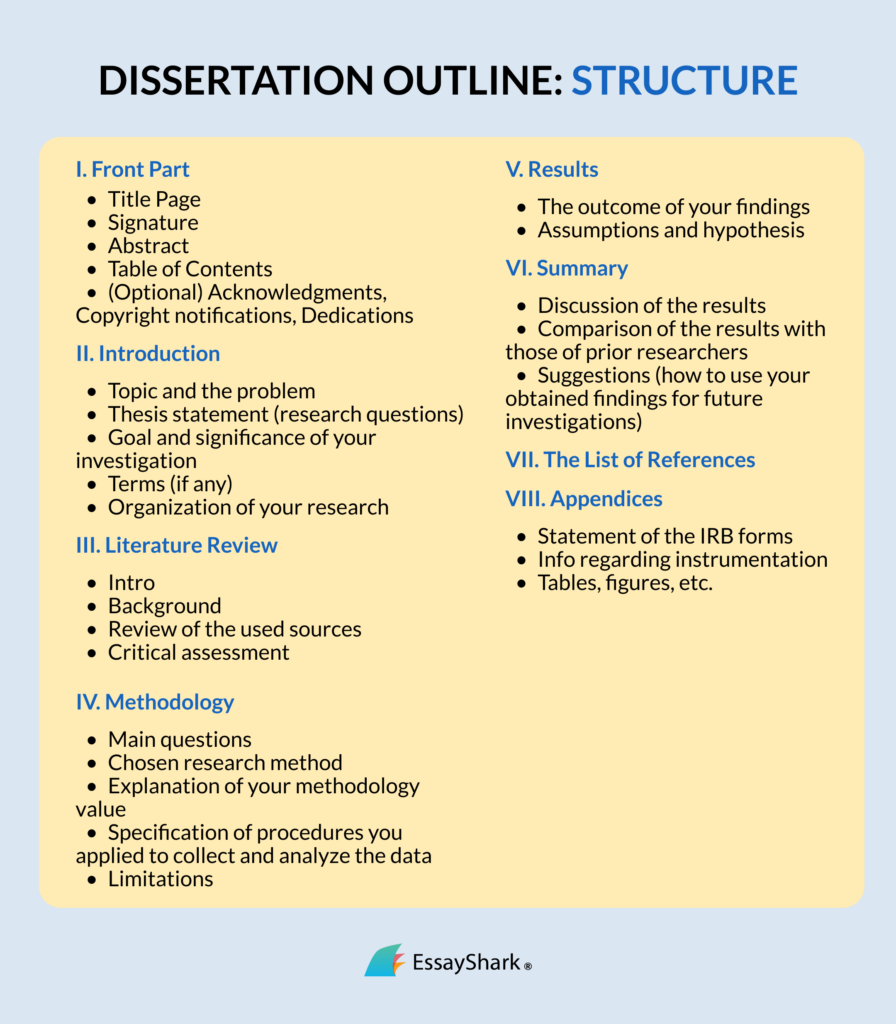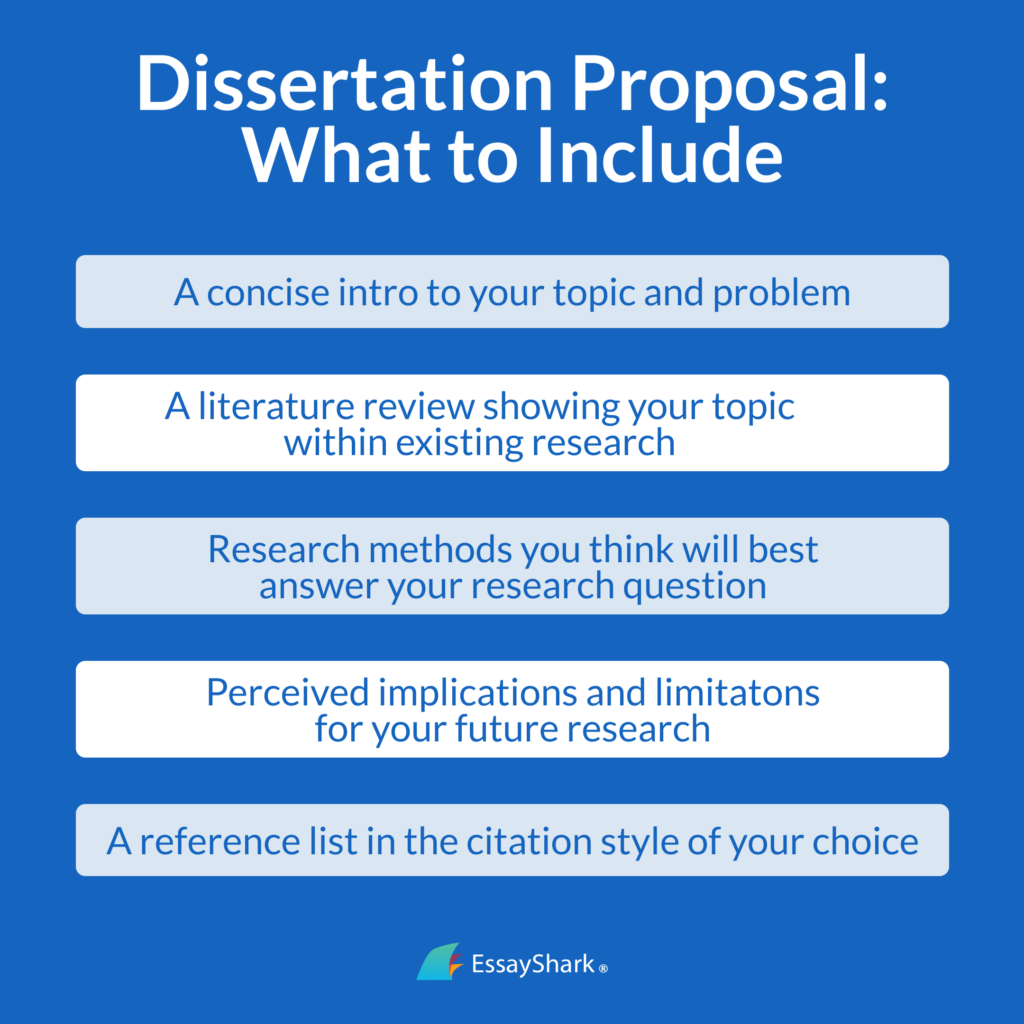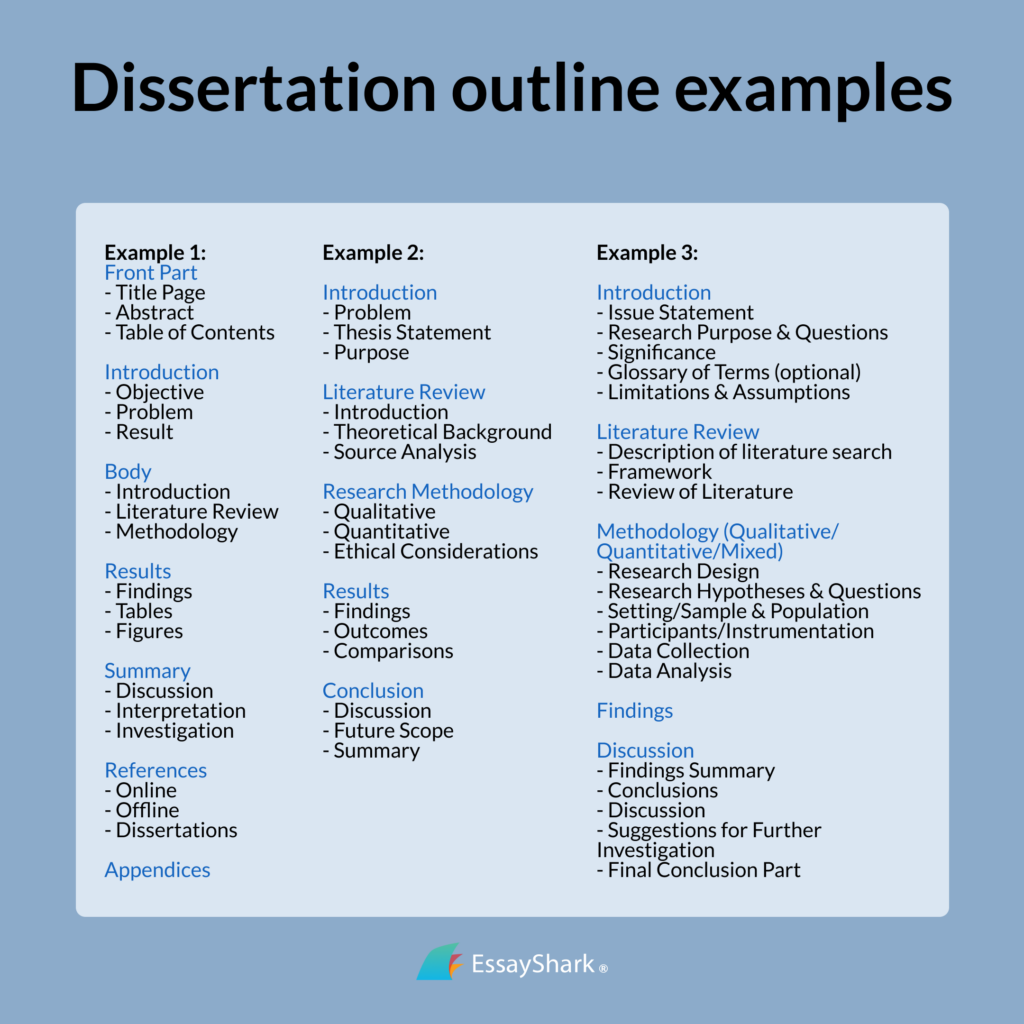You know that a dissertation is among the most challenging and time-consuming academic tasks, don’t you?
A dissertation outline makes this task easier. It’s a detailed plan of your future document that helps you identify its structure and research goals.
Table of Contents
In this article, you’ll learn how to write it. Our essay writers have prepared the steps for you to follow, actionable writing tips for you to consider, and a dissertation outline template you can refer to when the time comes to craft your dissertation plan.
So, let’s take a closer look.
What Is a Dissertation Outline?
A dissertation outline is the blueprint of your academic paper, where you prescribe all elements to use as reference material throughout the writing process.
The purpose is to make your work easier:
Since a dissertation is a lengthy paper with many sections, you should formulate a framework for each part to avoid trouble while writing. It allows you to work on the dissertation topic smoothly. See it as a master plan to succeed in the game of academic writing.
So, why write a dissertation outline?
- Bring order to ideas to avoid repetition while drafting
- Organize thoughts into paragraphs to avoid confusion and missing crucial points
- Arrange the flow, logically linking all the points together
Also, an outline may serve as a dissertation proposal to your college committee. As a young scientist, you submit it for supervisors to understand your general ideas and assess their relevance and potential for further research.
Let’s see how to write an outline for a dissertation.
Dissertation Outline Elements
A dissertation structure may vary slightly in different universities, but they all will ask for these five sections:
- Introduction
- Literature overview
- Methodology
- Data analysis
- Conclusion
But that’s not all.
Do you know how long is a dissertation? For a master’s, get ready to craft 12,000–50,000 words; for a Ph.D., your dissertation may look like a book of 70,000–100,000 words! It stands to reason that such a substantial academic paper can’t be of the same structure as a standard college essay or thesis.
Here’s a more detailed outline structure for your dissertation:

Keep reading to see what to include in each section of your outline.
Outline for Dissertation: Prewriting Stage
Here’s how to write a dissertation outline according to the academic experts of our dissertation writing help:
First, you prepare to write it (take some preliminary steps); then, you make notes (write) on every section of your future document.
Let’s discover that prewriting stage.
- Understand the guidelines
First, ensure that you’ve studied all the requirements and guidelines your college and supervisors have about dissertation work. You should know the expected structure and length, finalize your topic, and understand your research specifications.
- Study the topic context
Ensure you understand the prospects for the development of your future research. Examine the existing literature on your topic before deciding on the thesis statement for your paper: Read scientific works and take notes for your outline.
In other words, immerse yourself in the context of your topic to examine the specifics, gaps, and resources you’ll have to cover it.
Outline the scope of your research and formulate the research questions. Narrow the research area so that your paper won’t sound generic or superficial.
- Develop the thesis
What is the core statement you want to deliver in your dissertation? Compose the list of objectives beforehand so that you can bring them into paragraphs and arrange the flow.
With all the above in your pocket, you’ll have enough data to organize your research and outline every chapter of your future dissertation.
9 Steps to Writing Your Outline
- Title
- Abstract
- Introduction
- Literature Review
- Methodology
- Results
- Discussion
- Conclusion
- Bibliography/References
Here’s a standard dissertation outline example for you to get a better idea of this paper’s structure:

Now, let’s discuss the content to include in every dissertation chapter outline, step by step.
Title
A title is the front page of your dissertation. It’s like a book cover where you specify:
- Your topic (check our list of new psychology dissertation topics for inspiration)
- Your information (name, educational institution, course, your supervisor’s name, and date)
When writing an outline, it is enough to jot down the heading of the subject matter you’ll discuss. This will be your main heading.
Abstract
When we speak about dissertation abstracts, we mean the part that summarizes the key points in your research. It includes the objectives of your work, methods, participants, data analysis, results, and conclusions.
The purpose is to help readers understand if your dissertation is relevant to their expectations. Abstracts help the audience decide whether to continue reading your paper.
For an outline, briefly state the objectives, gaps in the previous research on the topic, and key results of your current research with the methods employed.
Introduction
It’s the start of your dissertation and should be strong enough to influence the reader at first glance.
An introduction in your outline of a dissertation includes:
- Background information on your topic
- Terms related to the issue
- Scope and importance of the subject matter
- A goal or a hypothesis you’ll reveal through your research
While framing the outline, highlight the imperative points and jot them in bullet points or any other formatting style.
Literature Review
Some students think that an introduction and a literature review are the same.
Wrong!
A literature review discusses prior work and your findings and then makes a comparison. You should include how your research contributes to your field of study. State the central points in an outline:
- Shortcomings of prior research
- Discovery in your study
- Comparison between your findings and existing work
Methodology
The methodology section contains the research methods you used for dissertation topics in education and many other disciplines. It discusses all the techniques and approaches used in your research process. You can also state the obstacles you faced while collecting the relevant data.
While preparing an outline, list the procedure in one or two lines.
- Methods or techniques used in collecting data (qualitative methodology, quantitative research methods, combined methodology analysis)
- Participants of your study
- Obstacles faced during assembling sources
- Ethical issues you encountered (if any)
Results
This section talks about the outcome of your research. You can include all the relevant data collected (tables, figures, etc.).
Please note that this section only requires a presentation of your discoveries. Be concise and logical; feel free to mention findings that didn’t support your hypothesis in your dissertation outline.
Discussion
The discussion section comprises assumptions and previous findings and explains why your research is credible. (It is particularly true for medical education dissertation topics.)
Analyze your findings respecting your stated research questions and logically connect the received information with your objectives.
You can also provide suggestions for future investigations on your topic or explain how your obtained findings can complement them.
Conclusion
A conclusion is the summary of your research. It answers a dissertation question and gives a reader a clear understanding of the argument. It’s the final chapter and a reflection of your findings.
In this section, you should prove how your research provides a new perspective to the old study.
Mention:
- The credibility of your work (how your discoveries contribute to the scientific community)
- Summary of the overall discussion (correspond to the objectives you set at the beginning of your research)
Bibliography/References
This section is a list of sources you used during the research. You’ll need to format it according to the required citation style (APA, MLA, or any other) and include both online and offline resources.
When you decide to buy dissertation from outsourced specialists, they often provide you with this chapter for free.
Dissertation Proposal Outline
Before crafting such a detailed outline for dissertation, you might need to create a dissertation proposal outline. Think of it as a promo of your future document for supervisors: Your task is to persuade a committee that your proposed research is worth pursuing.
When outlining your dissertation proposal, consider these questions:
- What do you already know about the topic?
- Why is your research significant?
- How, when, and where will you conduct it?
Include the following elements in your proposal outline:
- Topic introduction
- Aims and objectives
- Proposed methodology
- A literature review of the current research on your topic
- Implications and limitations of your research
- Bibliography

Depending on your educational institution, they may ask you to defend the proposal. You’ll prepare a presentation of your research plan for the committee to approve.
Please note that the average length for dissertation proposals is 25-30 pages. So, plan your outline accordingly.
Dissertation Outline Example
Here, we’ll show you several dissertation outline examples that you can use as a reference before preparing your future framework.
(For complete samples, please feel free to check our psychology dissertation examples.)

Over to You
A dissertation outline plays a vital role if you want your paper to be flawless. Now that you’re familiar with all the guidelines and norms, we hope you can draft the outline covering the main aspects.
So, take your time and curate it by covering all the primary components.
Are you still struggling with the question, “Who could write my dissertation for me?” We are here to assist you – don’t hesitate to ask!
Photo by Krzysztof Maksimiuk from Unsplash








